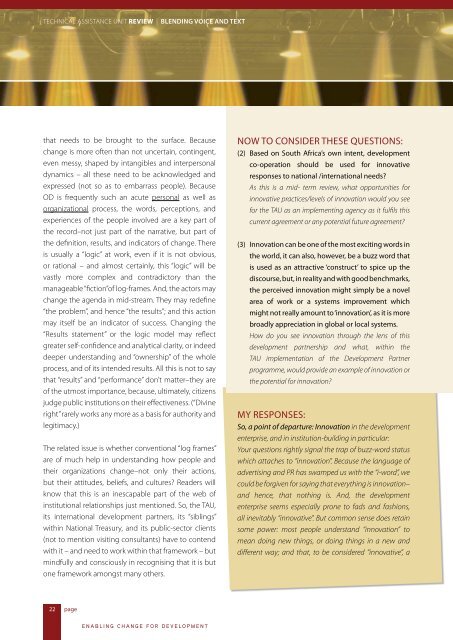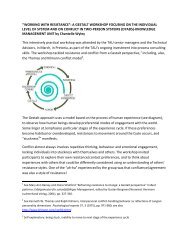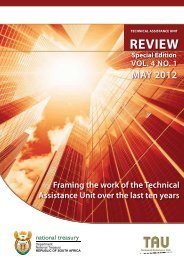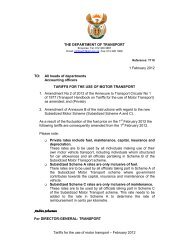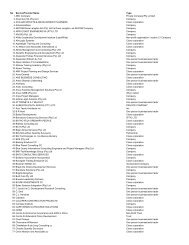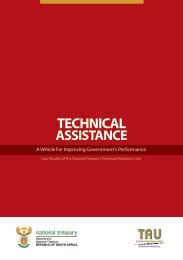Review 3 final 2 - TAU - National Treasury
Review 3 final 2 - TAU - National Treasury
Review 3 final 2 - TAU - National Treasury
You also want an ePaper? Increase the reach of your titles
YUMPU automatically turns print PDFs into web optimized ePapers that Google loves.
TECHNICAL ASSISTANCE UNIT REVIEW | Blending Voice and Text<br />
that needs to be brought to the surface. Because<br />
change is more often than not uncertain, contingent,<br />
even messy, shaped by intangibles and interpersonal<br />
dynamics – all these need to be acknowledged and<br />
expressed (not so as to embarrass people). Because<br />
OD is frequently such an acute personal as well as<br />
organizational process, the words, perceptions, and<br />
experiences of the people involved are a key part of<br />
the record–not just part of the narrative, but part of<br />
the definition, results, and indicators of change. There<br />
is usually a “logic” at work, even if it is not obvious,<br />
or rational – and almost certainly, this “logic” will be<br />
vastly more complex and contradictory than the<br />
manageable “fiction”of log-frames. And, the actors may<br />
change the agenda in mid-stream. They may redefine<br />
“the problem”, and hence “the results”; and this action<br />
may itself be an indicator of success. Changing the<br />
“Results statement” or the logic model may reflect<br />
greater self-confidence and analytical clarity, or indeed<br />
deeper understanding and “ownership” of the whole<br />
process, and of its intended results. All this is not to say<br />
that “results” and “performance” don’t matter–they are<br />
of the utmost importance, because, ultimately, citizens<br />
judge public institutions on their effectiveness. (“Divine<br />
right” rarely works any more as a basis for authority and<br />
legitimacy.)<br />
The related issue is whether conventional “log frames”<br />
are of much help in understanding how people and<br />
their organizations change–not only their actions,<br />
but their attitudes, beliefs, and cultures Readers will<br />
know that this is an inescapable part of the web of<br />
institutional relationships just mentioned. So, the <strong>TAU</strong>,<br />
its international development partners, its “siblings”<br />
within <strong>National</strong> <strong>Treasury</strong>, and its public-sector clients<br />
(not to mention visiting consultants) have to contend<br />
with it – and need to work within that framework – but<br />
mindfully and consciously in recognising that it is but<br />
one framework amongst many others.<br />
Now to consider these questions:<br />
(2) Based on South Africa’s own intent, development<br />
co-operation should be used for innovative<br />
responses to national /international needs<br />
As this is a mid- term review, what opportunities for<br />
innovative practices/levels of innovation would you see<br />
for the <strong>TAU</strong> as an implementing agency as it fulfils this<br />
current agreement or any potential future agreement<br />
(3) Innovation can be one of the most exciting words in<br />
the world, it can also, however, be a buzz word that<br />
is used as an attractive ‘construct’ to spice up the<br />
discourse, but, in reality and with good benchmarks,<br />
the perceived innovation might simply be a novel<br />
area of work or a systems improvement which<br />
might not really amount to ‘innovation’, as it is more<br />
broadly appreciation in global or local systems.<br />
How do you see innovation through the lens of this<br />
development partnership and what, within the<br />
<strong>TAU</strong> implementation of the Development Partner<br />
programme, would provide an example of innovation or<br />
the potential for innovation<br />
My Responses:<br />
So, a point of departure: Innovation in the development<br />
enterprise, and in institution-building in particular:<br />
Your questions rightly signal the trap of buzz-word status<br />
which attaches to “innovation”. Because the language of<br />
advertising and PR has swamped us with the “i-word”, we<br />
could be forgiven for saying that everything is innovation–<br />
and hence, that nothing is. And, the development<br />
enterprise seems especially prone to fads and fashions,<br />
all inevitably “innovative”. But common sense does retain<br />
some power: most people understand “innovation” to<br />
mean doing new things, or doing things in a new and<br />
different way; and that, to be considered “innovative”, a<br />
22<br />
page<br />
Enabling change for development


